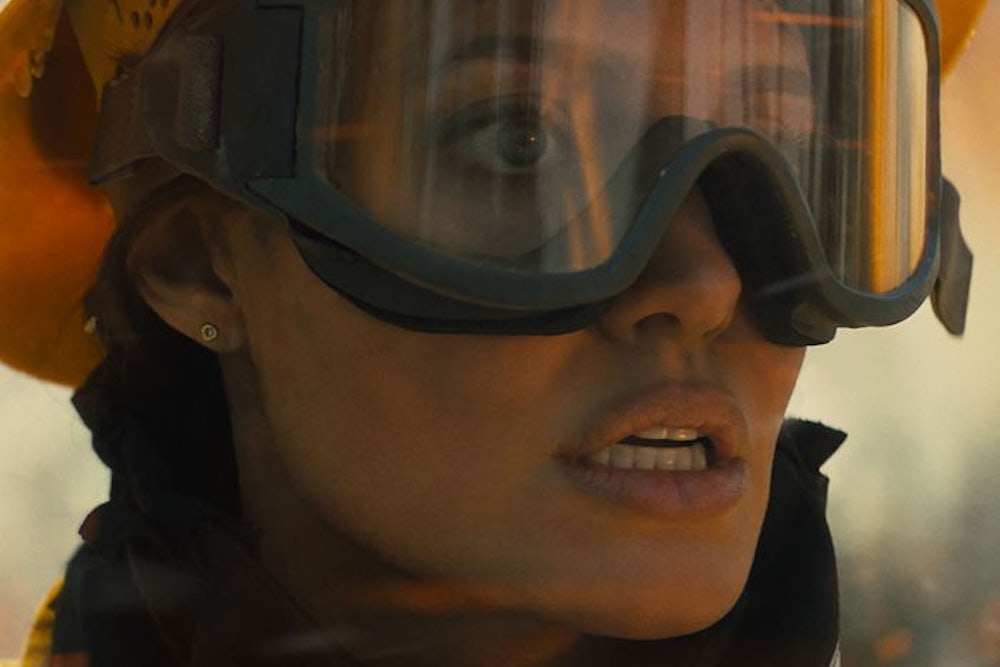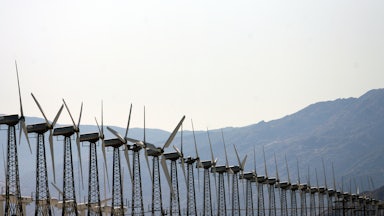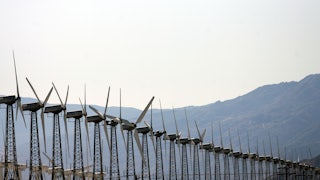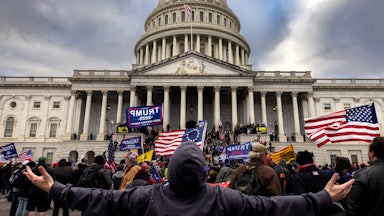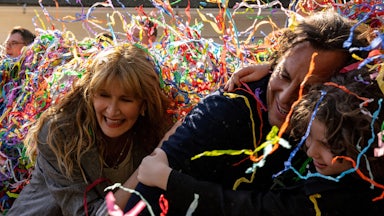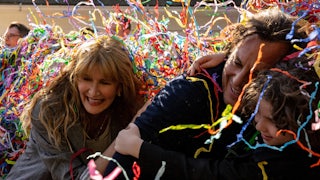There’s a scene in Those Who Wish Me Dead where Allison Sawyer, a heavily pregnant side character played by Medina Senghore, blasts a bad guy in the face with a lit aerosol can before riding away through the forest on a white horse. The mere fact of a Black outdoorswoman getting such cool action in a natural disaster movie, a genre that frequently treats white characters as the only ones worth saving, is refreshing in itself. But Those Who Wish Me Dead, which stars Angelina Jolie as a smokejumper—those firefighters who parachute in to fight wildland blazes—is surprising in a number of ways.
It could have been the blockbuster we’ve thirsted for since the pandemic began, forcing all the best-looking thrillers, like Sir Gawain and the Green Knight, A Quiet Place Part II, or the new James Bond movie, No Time to Die, to push their releases back. It could have been a fun, maximalist danger movie with nary a superhero in sight. Jolie has been out of the game for a little while—she has cited a “change in her family situation,” probably meaning her divorce from Brad Pitt, for her return to the screen—but she has built such a strong body of work as a glamorous action star that one expects more of the same.
But Those Who Wish Me Dead is about a very big fire and quite a small story. As Hannah, a firefighter assigned to a lookout tower in Montana after failing her psychiatric evaluation, Jolie doesn’t so much as touch a gun. Instead of the sexy violence she brought to films like Salt and Wanted, where she spent most of her time smizing down the barrel of a gun and exuding moral ambiguity, she’s flinty and melancholic here. When Hannah comes across a bloodied and crying boy named Connor in the forest, who is running from two very committed assassins, she feels a professional duty to protect him but struggles emotionally to pull it off.
Over flashbacks that get progressively longer and more detailed, we learn that she couldn’t save a group of boys from a forest fire some time ago—hence the failed psych eval. Jolie’s face is a bit immobile for how traumatized her character is supposed to be, and in those flashbacks she reacts to the dying children by raising one gloved hand to her mouth in a small and futile gesture. But the pain is unmistakable in her voice and body, and Jolie reminds us that she’s a great physical actor, no matter how much Botox the industry requires of a woman in her mid-forties.
Although the film works toward some seriously terrifying wildfire scenes, and Hannah gets to fight Nicholas Hoult with an ax, the role’s physical intensity largely comes from details like pouring rubbing alcohol onto her rope-burned hands or falling down a ladder. Finn Little, who plays Connor, her young charge, is similarly intense but undramatic, his tears frequently making little rivulets down his muddy face. It’s a bare-bones plot, and among the many things we never learn are the specific reasons that the bad guys (Hoult is sidekick to assassin number one, played by Aidan Gillen) are after Connor. But the longer Those Who Wish Me Dead sticks to its register of realistic peril, rather than fantastical stunt-craft, the odder still it becomes.
Natural disaster movies with thriller plots woven through them have been done to death. In classics like Jaws (if you count being eaten by a shark as a disaster) and Dante’s Peak, the local landscape takes revenge on mankind for the sin of prioritizing tourism dollars over safety. In Volcano, The Day After Tomorrow, Deep Blue Sea, and many more, the heroes’ warnings about impending disaster are ignored by local politicians for reasons like climate change denial, corruption, protecting reputations, or all of the above.
It’s much harder, however, to make a sweeping moral fable out of wildfire. For one thing, death by fire is too real: It’s common and horrific, especially in America where, in FEMA’s words, “The fire death rate … has been higher than most of the industrialized world” for a long time. Even worse, a 2010 study found that Black children and elderly people were at a heightened risk of death by fire and burns in this country. It’s not a fantasy, like lava flowing through the streets of Los Angeles. In this light, death by fire seems just too hideous to use more than sparingly in film. Even in horror movies, a single fire death (I’m thinking particularly of The Wicker Man) can be more than enough violence for a whole movie.
It’s also hard to make a visually sophisticated movie about fire. According to one visual effects designer I spoke to, it’s relatively easy to animate a simple fire but much, much harder to design a big fire interacting realistically with multiple three-dimensional objects in a complex setting.
As a result, it seems, few directors will even try to play with fire. Andrei Tarkovsky was fascinated by flame, but his fire sequences are mostly limited to individual candles—though a whole shack burns down spectacularly in Mirror (1975). Only a year earlier, The Towering Inferno established its permanent place in the (small) pantheon of blockbuster movies about firefighters. At over two hours long and boasting Paul Newman as architect and Steve McQueen as a firefighters’ battalion chief, the film works because it focuses more on those trying to solve the problem than the injuries or pain of any particular character. Only one major wildfire movie predates Those Who Wish Me Dead, namely 2017’s Only the Brave, a biopic about the Granite Mountain Hotshots so upsetting that I couldn’t finish it. The documentary Wildland leans into the sadness of working such a dangerous job and easily outstrips its fictional counterparts.
The effects here are astonishingly good, supported by actors who consistently remember where and how they’re supposed to be injured. Less realistic is the long, loose hairdo that Jolie wears throughout the movie, with one concession to a ponytail once the fire gets really close. The United States Fire Administration did not return my request for comment on whether Hannah’s hair complies with regulations, so I asked Barrett Doss, an actor on the ABC series Station 19, for her take on having hair while playing a female firefighter. While she said there were no really hard and fast rules that she was aware of, she’s had her hair “either braided or slicked down for the past four seasons,” and emphasized that anybody who “insisted on a full blowout before an action sequence would get checked pretty quickly.”
That one concession to glamor aside, Those Who Wish Me Dead ends up offering something quite radical within its understated package. By cutting down the scope of the Hollywood disaster movie from saving the world to saving one small, upset boy, the film presents an ultimately much more realistic vision of the human experience of climate peril. The problem with The Day After Tomorrow or any of its ilk, Jolie’s subtle performance suggests, is the lie they promulgate that anybody is really in charge or that justice will ever be administered from on high in the nick of time. If a wildfire ever threatens your life, there will be no Dennis Quaid (or Tommy Lee Jones, or Pierce Brosnan, or whoever) coming to your rescue. Wildfire is instead an unglamorous and endemic type of disaster, one that risks being normalized by the sheer frequency of its occurrence; Those Who Wish Me Dead is the rare movie with a healthy respect for its villain.
